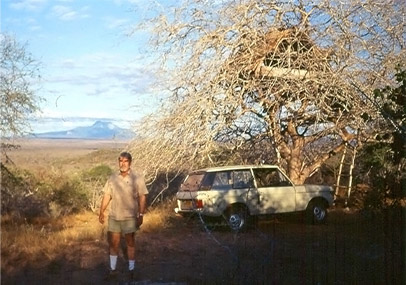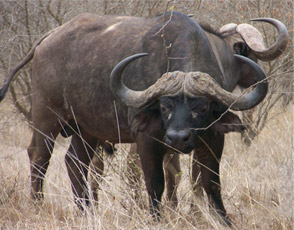
The History of Tsavorite
Discovered in Africa during the early 1960’s, the history of Tsavorite is best described by its discoverer, Campbell Bridges…
I initially discovered Tsavorite in 1961 in Zimbabwe while working for the United Kingdom Atomic Energy Authority (UKAEA). We were locating and assessing beryl deposits as beryllium was thought at the time to be the best metal for lining atomic reactors. A geological map showed that a range of hills near my camp contained an interesting combination of different rock types that could well have resulted in the formation of gemstone or other mineral deposits. So one Sunday, when I was off duty, I set out to explore an area near the top of these hills. As I was making my way up the edge of a steep gully, an old rogue buffalo charged out of the bush at me. I jumped down into the gully. The buffalo followed me in a menacing manner along the edge of the ravine for a while, then gave up and went off into the bush. I continued upward, inspecting the rock exposures in the bottom and sides of the gully. Where it neared the top of the hill, I found an outcrop that contained small bright green crystals. This was my first encounter with green garnet.

Campbell Bridges outside his treehouse.
My second discovery of green grossularite garnet occurred in northern Tanzania in 1967. It occurred in a small hidden valley in a low range of hills just over 100 kilometers southwest of Kilimanjaro, about 13 kilometers southeast of the village of Komolo. Between Komolo and these hills, lies a belt infested with tsetse fly. Sansivera (wild elephant sisal) was abundant in this valley and because of this ready food supply; a large rhinoceros had made this area his home. The following morning after we had dug a new pit in our search for the green gem, we would find the rhino’s tracks firmly implanted in the soil on the edge of the pit. For this reason he came to be known as “The Mining Inspector” and a sharp eye was always kept out for him as we walked along the narrow trails through the sword-tipped elephant sisal.
A characteristic inclusion of the green garnet from this area was open capillary tubes (sometimes containing gypsum) and when abundant, they resembled a bank of reeds within the body of the stone. The colour of the grossularite at this location ranged from pale to a fine rich grass-green.
Subsequently, this deposit yielded for a short time some of the largest Tsavorites ever found, among which is one beauty just under 35 carats. But that was long after I had lost the mine due to nationalization by the Tanzanian government and moved to Kenya.

Standoff with an African Cape Buffalo.
Towards the end of 1970 I had located a small range of grey, humpbacked hills in southeast Kenya, 135 kilometers southeast of Mt. Kilimanjaro, not unlike the hills of Komolo in appearance. More important, these hills formed a part of a belt of similar rock-types to those in which the green garnet of Tanzania occurred. Before the end of 1970 I had found my first Kenyan green garnet in these hills and in 1971 pegged the first blocks of mineral claims. The area was uninhabited and comprised Hunting Block No. 64. Lying close to the borders of the Tsavo National Park, elephant, lion and other wild game were abundant. To keep cool during the scorching days of the hot summer months, we constructed a sturdy tree-house in a large Gambol Flam tree (Delonix elata) on the side of a hill with a magnificent panoramic view out over the plains to the east. Between the tree-house and the coast, the skyline is broken by the great block mountain of Kasigau, rising sheer out of the plain for more than 1,000 meters. Each morning the sun rises in a blaze of glory behind this mountain and as the shimmering air cools towards evening a little cloud appears and lands like a flying saucer on top of Kasigau. At various seasons the tree blossoms and surrounds the tree-house with beautiful orchid-like flowers.
When we were away from the tree-house for any length of time, one of the two leopards that inhabited the range would drag its kill (usually a lesser kudu) up the tree and eat it on my bed. For a short while after our return he would express his displeasure by walking around the tree at night, growling and clawing at the bark, though he still had the benefit of drinking water from the Tsavorite (green garnet) studded bird bath at the bottom of the tree.

Henry B. Platt, former President of Tiffany & Co., with Campbell Bridges.
In late 1973 Henry B. Platt, then President of Tiffany & Co., who had taken a keen interest in my discoveries right from the start, decided that it was time to give this gem a trade name. Modern mineralogical nomenclature dictates that the naming of a mineral must end with “ite”. As Tsavo was the obvious locality choice, Mr. Platt and I named the magnificent fiery green gemstone “Tsavorite”, while the Germans proposed the name “Tsavolite.”
CIBJO, originally a European confederation founded in 1926 as BIBOA, was expanded in 1961 and renamed CIBJO (Confederation Internationale de la Bijouterie, Joaillerie, et Orfevrerie). Among other purposes, it cements nomenclature and sets ‘best practice’ guidelines to better engender consumer confidence. CIBJO made a ruling to accept the name ‘Tsavorite’. The rest is history.


